City Market
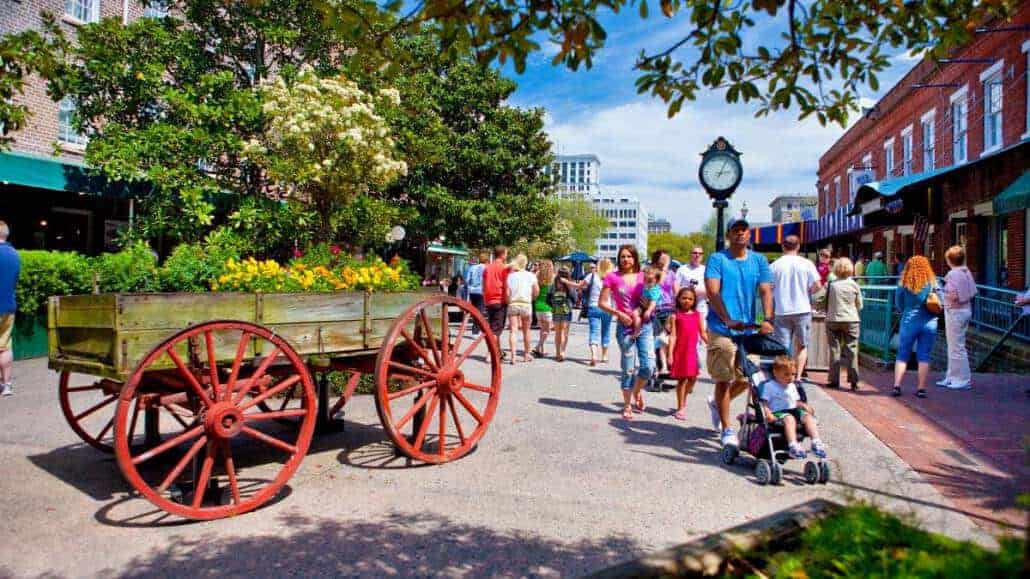
Just past Ellis Square, Savannah’s historic City Market dates back to 1755. The first four incarnations of the market have been lost to history, victims of fires and general decay. Many old warehouses have survived, however, and now house a thriving and eclectic mix of galleries, nightclubs, eateries, gift shops and antique stores. Most days there is some form of entertainment, and many of Savannah’s historic tours embark from this area of the city.
Savannah Carriage Tours
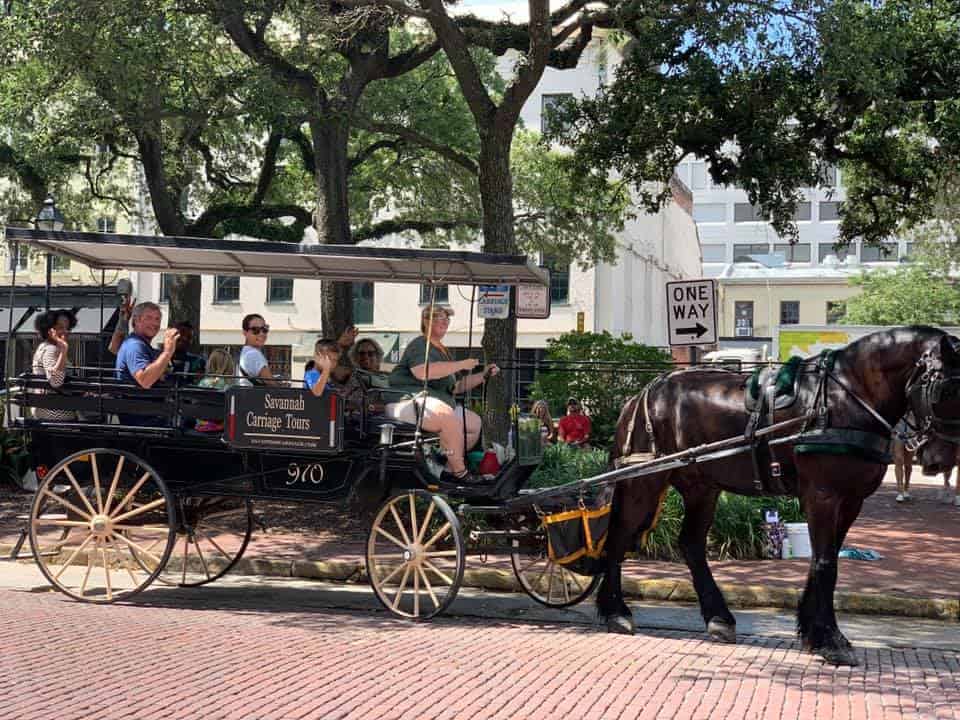
Due to hot weather concerns, it’s best to schedule your tour before 11 am in the summer. Tour can be cancelled if over 90 degrees.
Our Pubic History Tours cover approximately 8 of Savannah’s beautiful squares and last 45-50 minutes. Sit back, relax and enjoy the narration of Savannah’s rich history while your horse clip-clops past unique landmarks and historic homes.
Tours departs in front of the Hyatt Regency Hotel.
They monitor the temperature outdoors as well as the horses internal temperatures to ensure that our horses never work in extreme conditions! The horses are hosed down regularly once outdoor temps reach 85. They are also offered water before, during and after each tour.
Chippewa Square
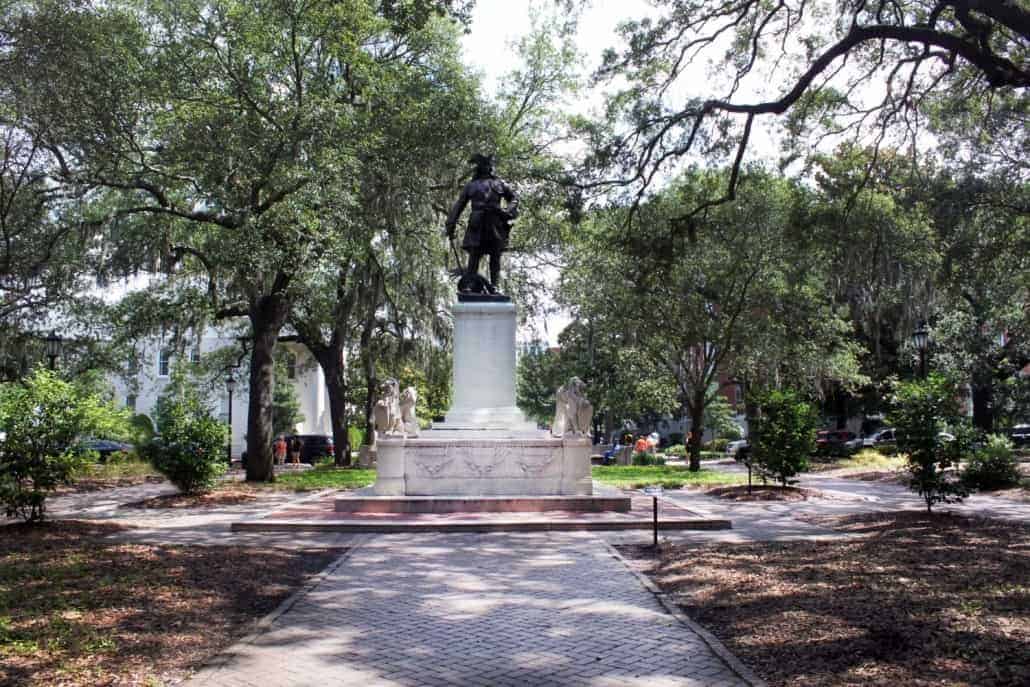
Chippewa Square is located on Bull Street between Hull and Perry Streets. Standing here you are at the very heart of Savannah’s Historic District. Named for the Battle of Chippewa during the War of 1812, the square was built in 1815.
- In the center of the square stands the imposing statue of James Oglethorpe. Sculpted by Daniel Chester French in 1910, the statue depicts Oglethorpe in light armor wearing period clothing and a tricorn hat. Four lions surround the pedestal with shields that bear seals for the city of Savannah, the Colony of Georgia, the State of Georgia and James Oglethorpe’s personal coat of arms. The base is inscribed with quotes taken from the original Georgia charter. Much is made of the fact that Oglethorpe’s statue faces south. This is due to the tradition of facing statues toward their historic enemies. In Oglethorpe’s case, the enemies he faced were the Spanish who had come north from Florida. In a small battle known as the Battle of Bloody Marsh, Oglethorpe and his men secured the lower Atlantic coast for England by repelling Spanish forces from St. Simons Island, about 75 miles south of Savannah.
- FORREST GUMP – If Chippewa Square looks familiar to you, it should. The square featured prominently in the critically acclaimed film “Forrest Gump.” Tom Hanks’ character spent a great deal of time narrating his life story from a park bench in Chippewa Square, The bench itself was a fiberglass prop, and can now be seen at the Savannah Historical Museum.
- SAVANNAH THEATRE – Chippewa Square isn’t only known for its contributions to the silver screen. The square is also home to the Savannah Theatre, the oldest playhouse in continual use in the United States. The theater has survived for nearly two centuries, struggled through changes of ownership, and endured a series of fires and reconstructions. Legend has it that Lincoln assassin John Wilkes Booth played at the Savannah Theater in the 1850’s with his brother, noted actor Edwin Booth. As the years went by the theater would undergo many changes, including being renamed the Savannah Opera House in 1894 and burning to the ground in 1906. It is widely acknowledged that the theater was a victim of arson at the hands of the Ku Klux Klan, who sought to prevent a production of Thomas Dixon’s controversial play “The Clansman.”
The theater was ravaged by fire again in 1944 and again in 1948. Fortunately, though repairs were made, enough of the original structure was saved to enable the theater to hold on to its status as the country’s oldest playhouse. At present the Savannah Theater is seeking federal funds for further restoration.
- STODDARD HOUSE – The Stoddard House (also known as the Philbrick-Eastman House) located at 17 West McDonough Street, is best known for its wrought iron fence bearing silhouettes of prominent men. If you completed Tour #1, you have seen the same ironwork around the fountain in front of the Cotton Exchange on Bay Street. Although construction of this Greek revival home was started in 1844 for the Eastman family, it was not completed until 1847 for John Stoddard. This elegant residence has housed several important Savannah families, which is why there is sometimes confusion about the building’s name.
- FIRST BAPTIST CHURCH OF SAVANNAH – The First Baptist Church of Savannah, Georgia, was chartered on November 26, 1800, and the present church on Chippewa Square was completed in 1833. The Greek revival building has been enlarged over the years, with an addition constructed in 1839. Further renovations were completed in 1966, 1989-1990, and 1998-1999.
- SIX PENCE PUB – Located just north of Chippewa Square on Bull Street is an authentic reproduction of the typical 18th-century English pub. You may recognize it from the movie “Something to Talk About,” when the character played by Julia Roberts shows up in her nightgown to confront her husband, played by Dennis Quaid, about his infidelity.
Cathedral of St. John the Baptist
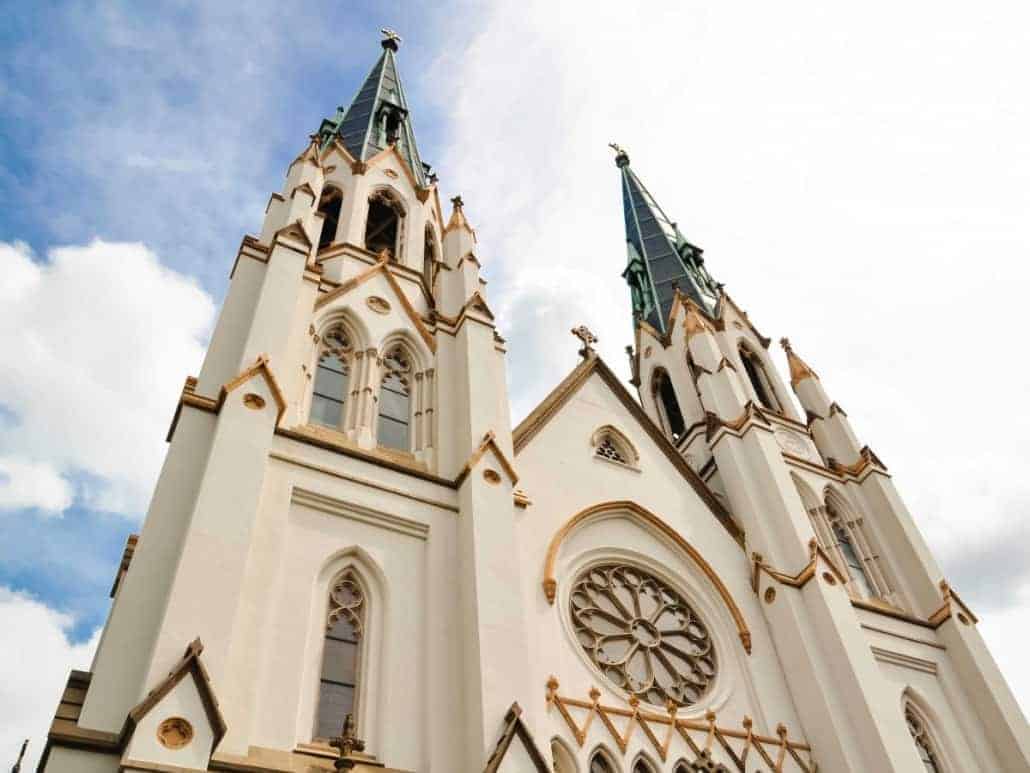
The Cathedral of St. John the Baptist is the oldest Roman Catholic Church in Georgia. The grand Victorian cathedral was designed by noted architects Baldwin and Price in the 1870s.Destroyed by fire in 1898, the cathedral was immediately rebuilt from the original plans. In addition to the distinctive Victorian design, the cathedral features magnificent stained glass windows, which were made by Innsbruck Glass makers in Austria and installed around1900. The cathedral is open for touring. Go through the front doors. It’s free, although donations are accepted.
Bonaventure Cemetery Tours
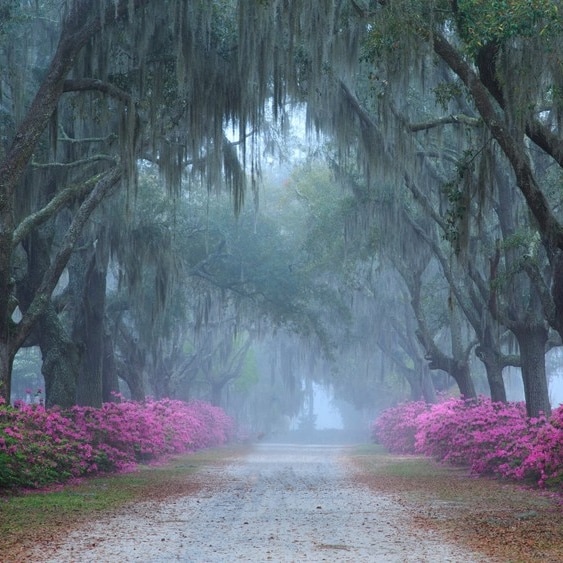
This is a guided walking tour
One of the oldest sayings in Savannah is, “No visit to Savannah is complete without a visit to Bonaventure Cemetery,” and with 800,000 people a year exploring 150+ acres of natural splendor mixed with statues, ironwork, and some of Savannah’s most famous reposed lying in state, you’ll soon understand why this should be at the very top of your Savannah-To-Do-Bucket-List! And, if you’re a present fan or one to be of “Midnight In The Garden of Good & Evil,” this Savannah walking tour is a no-brainer. A number of the “characters” are buried here, and the cemetery itself is a setting for some of the book’s important scenes.
Originally a 1750’s plantation that became Savannah’s great park during both Industrial Revolutions, Bonaventure became not only Savannah’s chief escapist place, but true to Savannah form, their setting for cocktail hour at sunset! Because of all this it was, and still remains, a great point of pride that we became the first company to offer daily cemetery tours in Bonaventure; to share her secrets and her serenity with visitors from all over the world!
History and Points of Interest on Tour:
- Tour duration: 2 hours
- Bonaventure Plantation: The history
- Freemasonry: Secret societies revealed
- Little Gracie: Savannah’s guardian angel
- Johnny Mercer: 1,568 songs, 4 Oscars & Moon River
- Conrad Aiken: Poetry & martinis at sunset
- John Walz: Savannah’s greatest sculptor
- Harry Hervey: Screenwriter & novelist
- Corinne Lawton: Romantic rebel
- Symbolism, funerary rites, & much more!
- Tour provided by Sixth Sense Tours
Andrew Low House Museum
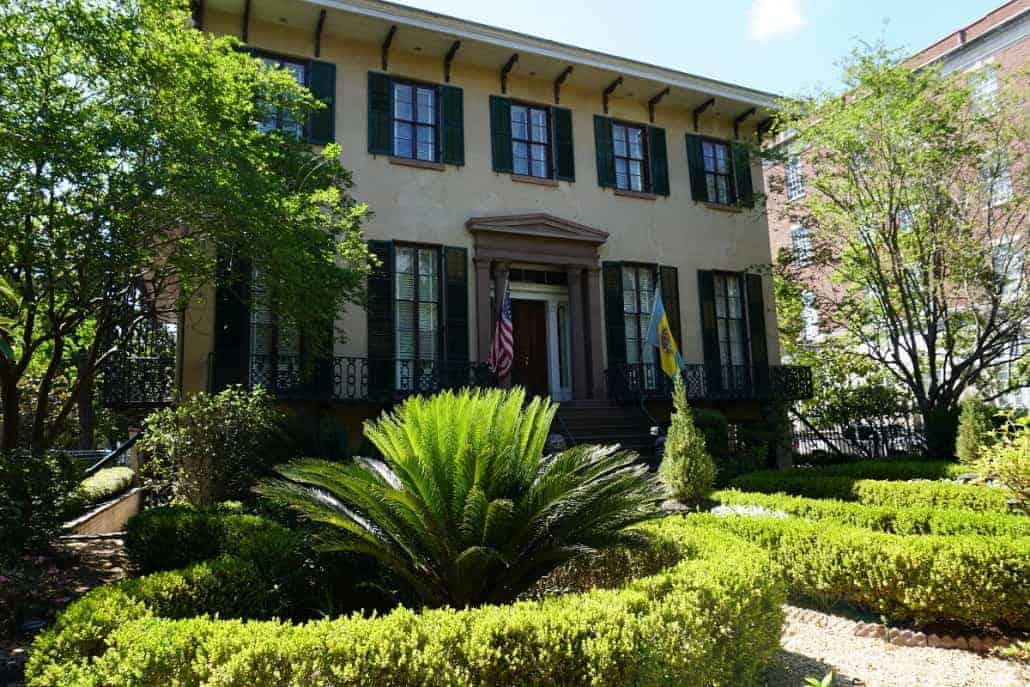
The lovely brick Andrew Low House combines Grecian details with elements of the Italian Villa style and boasts one of Savannah’s most stunning ironwork balconies. A shuttered piazza overlooks a beautiful brick-walled garden in the rear of the home. The front garden remains much as it did when first planted, with two hourglass-shaped flowerbeds. Handsome inside as well as the out, the Andrew Low House features spacious rooms decorated with beautiful plaster cornices and carved woodwork.
New York architect, John Norris, designed and built this lovely home in 1848-1849 for Andrew Low, a wealthy cotton factor, who came to Savannah from Scotland when he was only 16 years old. He started working in his uncle’s cotton firm and later became a partner and later director of the Savannah operation. In 1843 he married Sarah Cecil Hunter. Unfortunately, Andrew’s wife and 4-year old son died before the house was complete. Five years later, Andrew married Mary Cowper Stiles, daughter of William Henry Stiles, United States Minister to Austria. During the Civil War, Andrew Low was imprisoned at Fort Warren in Boston harbor on suspicion of collaboration with the Confederacy.
The Andrew Low House was host to several important visitors over the years. One such visitor was English author, William Makepeace Thackery, who visited in 1853 and 1856 while on lecture tours.
Know that I write from the most comfortable quarters I have ever had in the United States. In a tranquil old city, wide stretched, tree-planted, with a few cows and carriages rolling through the sandy road, a red river with a tranquil little fleet of merchant men taking cargo, and tranquil ware-houses barricaded with packs of cotton; a famous good dinner, breakfast, etc. and leisure all morning to think and do and sleep and read as I like. The only place I stay in the United States where I can get these comforts — all free gratis — is in the house of my friend Andrew Low of the great house of A. Low and Co, Cotton Dealers, brokers.
William Makepeace Thackery
In 1870, Robert E. Lee, former commander of the Army of Northern Virginia paid a visit to Savannah with his daughter, Agnes. The general left the train to face one of the largest crowds that ever assembled to welcome him. Cheer followed cheer. As soon as the crowd would permit, Lee was driven to the home of General Lawton, at the corner of York and Lincoln Streets. Later in the evening he was taken to the Andrew Low House, where he was to sleep.
The Lowes invited some of Lee’s old comrades to dinner on April 2. General Joseph E. Johnson, General Andrew Lawton and General J. F. Gilmer came to pay their respects. It was the first time Lee had seen Johnson since the war. Before leaving Savannah, Lee paid a visit to Joseph Johnston, who was then living at 105 E. Oglethorpe Avenue. At some point during his stay, Lee and Johnston were photographed together at Ryan’s, a local photography studio in downtown Savannah. The familiar picture shows them, “grizzled, old and feeble,” seated on opposite sides of a small table.
That spot of spots! That place of places!! That city of cities!!!
Robert E. Lee to Savanahian Jack MacKay
Andrew Low’s son, William Mackay Low, married Juliette Gordon in 1886. Juliette, commonly known as Daisy, moved in the family home on Lafayette Square. It was here that the widowed Juliette founded the Girl Scouts of America. Daisy had become friends with General Robert Baden-Powell, former of the Boys Scouts of England. Baden-Powell and his sister, who had formed a society of “Girl Guides” in England, inspired Daisy to found a similar organization in the United States. She formed two such groups of girls in Savannah in 1912. Members of the Girl Guides, later known as the Girl Scouts, held their meetings in Daisy’s carriage house. Juliette Gordon Low died in 1927 and bequeathed the carriage house to the Savannah Girl Scouts. The National Society of the Colonial Dames in Georgia purchased the Andrew Low House in 1928. After painstaking restoration, the Colonial Dames used the home as their headquarters, and officially opened the home to the public in 1952.
A Walk Through Midnight
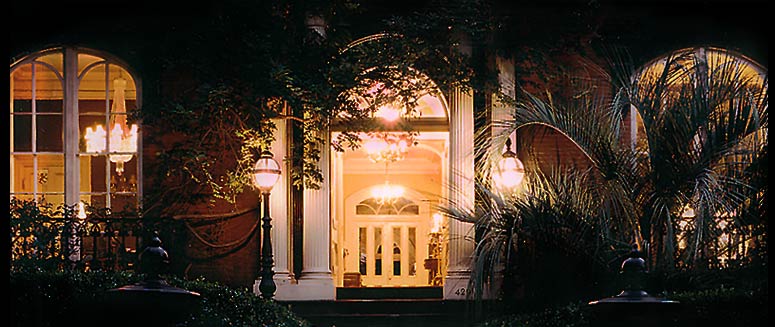
Truth is truly stranger than fiction. Who would have thought that a story about characters in a sleepy little southern town would have created such a stir?
- Tour Duration: 1.5 hours
- Tour Highlights: Unique walking tour based on the best selling novel, Midnight in the Garden of Good and Evil, A Savannah Story.
- See the sights made famous by this novel which became an International Phenomenon.
- Rated by Walking Magazine as “One of the 10 Best Walking Cities in America.”
- Tour begins at Oglethorpe Square.
Shocking soirees. Scandalous affairs. Don’t let the Southern charm fool you.
Even the rumors whispered beneath dripping Spanish moss are enough to make a man blush – and it’s all true! Just another day in this eccentric city…. The Savannah Walks is proud to present A Walk through Midnight, a saunter through the pages of John Berendt’s runaway bestseller, Midnight in the Garden of Good and Evil.
Palmetto Carriage Tours
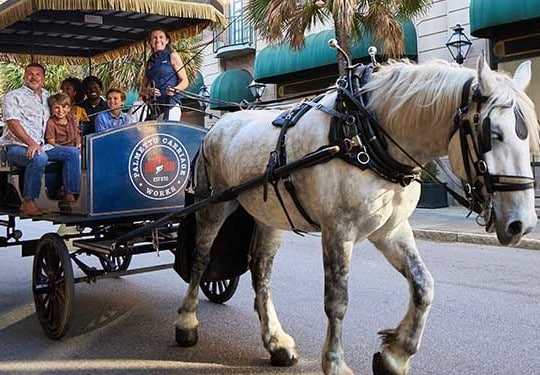
Palmetto Carriage Works is the oldest carriage tour company in Charleston and has developed the greatest carriage experience in the city! A Palmetto Carriage tour offers a blend of knowledge, wit, humor and history and is exciting and ever changing, a seamless fusion of 19th century conveyance in a 21st century city.
During this tour you will:
- Tour duration: 60 minutes/li>
- Experience 25-30 blocks of Charleston’s historic downtown district
- See houses, gardens, mansions, churches & parks
- Learn about buildings, history, architecture, flora & the people that make up the “Holy City”
- Learn everything that Charleston has to offer on a Palmetto Carriage tour
When are animals pulled from service to do heat?
When the temperature reaches 95 degrees or the heat index reaches 110, carriage tours are halted. Additionally, PCW rectally checks the temperature of each animal before and after every tour, year round to ensure that it stays within the normal range of 98.7 to 101.5 degrees. If the animal’s temperature exceeds 102.9 degrees, it is pulled from service. Charleston is one of the only cities in the world where the animals are monitored individually. There has never been a heat related incident in over 30 years of business.

